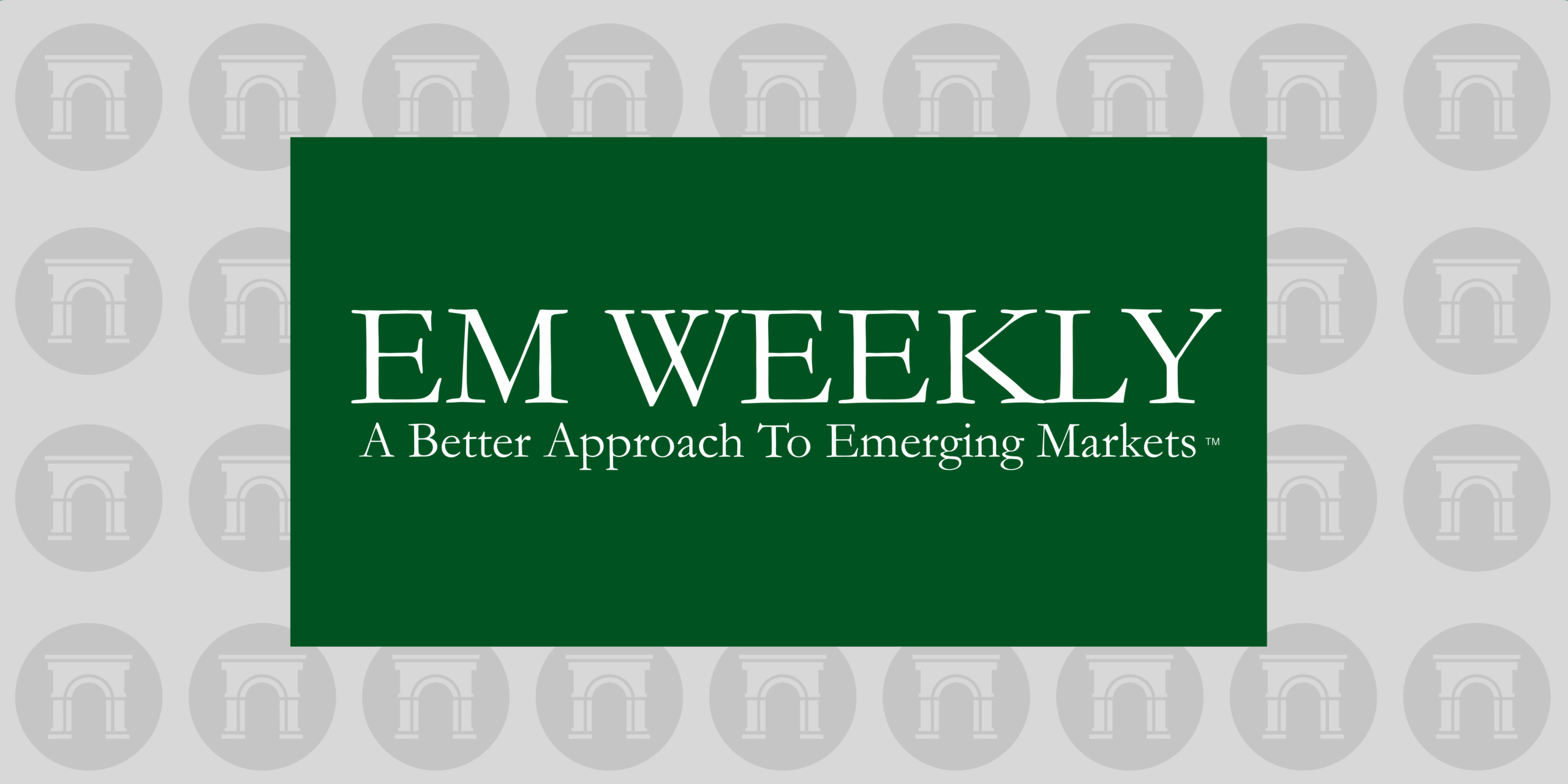Contents
Market Overview
Macro Update
Continued focus on Federal Reserve independence dominated the macro narrative this week, as U.S. President Donald Trump stopped by the central bank to inspect ongoing renovations of the Fed’s building in Washington, DC. – the first time in at least two decades a U.S. president has visited the Fed. Mr. Trump said Thursday he won’t fire Fed Chair Jerome Powell, as he thinks that Powell is “going to do the right thing,” which reassured markets. But his decision to visit the Fed could be interpreted as a further escalation of White House pressure on Mr. Powell. Meanwhile, Treasury Secretary Scott Bessent, in a televised interview, called for a review of the Fed as an institution, as did Speaker Mike Johnson. While later affirming support for central bank independence, Secretary Bessent also raised concerns about potential “mission overreach.” These developments coincided with mixed U.S. economic data, which may further complicate the Fed’s near-term policy stance.
Labor market conditions remained broadly stable this week. Initial jobless claims came in at 217,000, slightly below expectations, and continuing claims held steady at 1.96 million. Meanwhile, preliminary July PMI data painted a mixed picture: Manufacturing fell into contraction at 49.5 (from 52.9), its lowest level in seven months while, conversely, services and composite readings rose to their highest levels in this period (55.2 and 54.6, respectively). In corporate earnings, General Motors reported a $1.1 billion hit from tariffs in the second quarter, with net income down by roughly one-third to $3 billion. The company is absorbing higher input costs for now but has not ruled out price increases.
On the trade front, the U.S. announced a new agreement with Japan that will impose 15% reciprocal tariffs – higher than the current 10% but below the 25% previously considered. President Trump stated the deal includes $550 billion in prospective Japanese investment in the U.S., though provided few details. The agreement was viewed as a potential template for future negotiations, including with the European Union. The announcement came as Japan’s ruling coalition suffered a defeat in the upper house elections, adding a layer of political uncertainty around the country’s ability to follow through on new international commitments.
U.S. financial markets finished the week higher, with major equity indices reaching new highs. Treasury yields declined modestly, with the 10-year at 4.40% and the 30-year at 4.96%. The dollar weakened, with the DXY falling to as low as 97, ending the week around 97.7. Oil prices gave back recent gains, settling in the mid-$60s.
In Europe, the European Central Bank held its main policy rate at 2.0%, pausing after eight consecutive cuts. ECB President Christine Lagarde signaled a somewhat more hawkish, data-dependent approach amid global uncertainty. Eurozone consumer confidence improved slightly in July, and PMI data surprised to the upside for services (51.2) and composite (51.0), while manufacturing remained just below neutral (49.8). France and Germany’s readings hovered around the 50 mark. In the UK, manufacturing rose to 48.2, while services and composite softened slightly but remained in expansion territory.
Meanwhile, the EU–China summit concluded without progress on key issues, as both sides maintained firm positions on trade and Ukraine. The outcome underscored the structural challenges that have limited improvement in the bilateral relationship.
In emerging markets, Türkiye resumed its rate-cutting cycle, reducing its policy rate by 300bps to 43% after a pause earlier this year triggered by domestic political events. Central banks in Hungary, Nigeria, Sri Lanka, and Ukraine all held rates steady, in line with expectations. Ukraine’s government estimated military spending needs of $120 billion for 2026, while expectations for progress in talks with Russia remain limited.
Additionally, reports emerged that the U.S. may allow Chevron to resume operations in Venezuela, signaling a possible easing of tensions following a recent prisoner exchange with the government of President Nicolás Maduro. Meanwhile, a long-running border dispute between Thailand and Cambodia escalated into more significant fighting, resulting in at least 11 fatalities.
EM Credit Update
Emerging market hard currency sovereign debt posted a solid gain of 0.61% this week, with high yield outperforming investment grade (0.82% vs. 0.40%) as risk appetite returned to the market. At the index level, sovereign spreads tightened by 7bps, driven primarily by a 14bps compression in high-yield, while investment-grade spreads remained largely unchanged (-1bp).
Regionally, Africa and Latin America led performance, with notable strength in Venezuela and Senegal. Venezuela rallied after the prisoner exchange on renewed speculation that the U.S. may ease sanctions and potentially allow Chevron to resume operations. We say above Senegal benefited from headlines that the IMF will begin discussions next month on a new program, which helped attract buyers despite recent credit downgrades.
Pakistan also outperformed, buoyed by an S&P upgrade from CCC+ to B-, while Ukraine lagged amid political backlash over President Volodymyr Zelenskiy’s attempt to limit the independence of anti-corruption agencies.
In local currency debt, EM sovereigns gained 0.59% as renewed pressure on the dollar supported flows. The segment is now up 13.1% year-to-date. Euro-adjacent EM currencies such as PLN and CZK led the gains against the USD. On the other end of the spectrum, Colombia’s local debt underperformed amid continuing fiscal uncertainty under the administration of President Gustavo Petro.
EM corporate debt delivered a more modest return of 0.28%, with high yield slightly ahead of investment grade (0.33% vs. 0.25%). Credit spreads were broadly stable (-3bps), and returns were driven by names in the ‘B’ and ‘C’ rating buckets. Africa and Europe were the strongest contributors at the regional level.
Primary market activity was subdued, with only four deals pricing. No sovereigns came to market, and corporate issuance was concentrated in high yield. Notably, a debut Turkish high-yield issuer pulled its deal after investors balked at pricing near 12%, suggesting that investors remain selective despite the ongoing search for yield.
The Week Ahead
Market attention will be focused on the extended August 1st tariff deadline, potentially leading to higher rates if more deals are not reached. The upcoming U.S. July employment report is expected to show slower gains compared to June’s 147,000 new jobs, with an anticipated uptick in unemployment. Other important U.S. data releases, such as the Conference Board’s consumer confidence, JOLTS job openings, U.S. consumer income/spending, the PCE price index, jobless claims, S&P Global’s manufacturing PMI, ISM manufacturing, and the University of Michigan consumer sentiment survey, will provide further insight into U.S. economic health under trade uncertainty.
The Fed is expected to hold rates steady in a target range of 4.25% to 4.5% amid intensifying pressure for a cut by President Trump and his allies. The Bank of Japan (BOJ) is also expected to hold rates at 0.5% given global trade and economic uncertainty.
2Q GDP estimates will be published by Spain, Czech Republic, the eurozone, France, Germany, Hungary, Italy, Mexico, U.S., Canada, and Taiwan, while preliminary July CPI will be reported by Australia, Spain, France, Germany, Italy, Poland, Sri Lanka, and Austria. In addition to the U.S. and Japan, central bank rate decisions are due in Chile, Brazil, Canada, and Colombia.
In the corporate world, major tech companies like Apple, Samsung, and Amazon are reporting their earnings. Other notable events include Secretary Bessent’s meeting with Chinese counterparts in Stockholm for a third round of trade talks, and President Trump’s private visit to Scotland, where he plans to meet with UK Prime Minister Keir Starmer. Taiwan is set to hold its biggest recall election ever to decide whether 24 opposition Kuomintang party lawmakers will remain in office.
Fixed Income

Equities
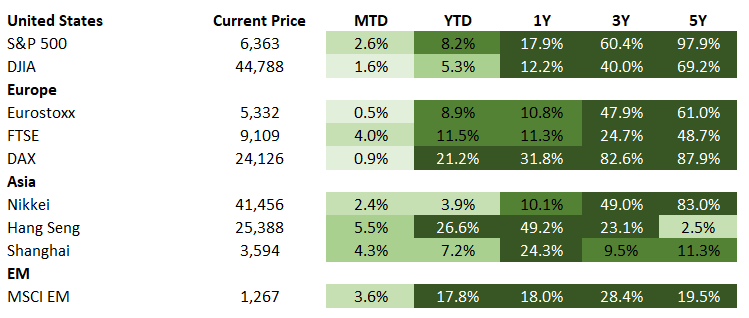
Commodities

Source for data tables: Bloomberg, JPMorgan, Gramercy. EM Fixed Income is represented by the following JPMorgan Indicies: EMBI Global, GBI-EM Global Diversified, CEMBI Broad Diversified and CEMBI Broad High Yield. DM Fixed Income is represented by the JPMorgan JULI Total Return Index and Domestic High Yield Index. Fixed Income, Equity and Commodity data is as of July 25, 2025 (mid-day).
Highlights
U.S.-Venezuela Prisoner Swap Suggests Back-Channel Talks Have Re-Opened
Event: U.S. Secretary of State Marco Rubio announced a deal to repatriate Venezuelan prisoners in El Salvador in exchange for 10 detained Americans, as well as several Venezuelan political prisoners. According to the WSJ, Chevron and other companies may be regaining the ability to pump oil, on better terms, in Venezuela.
Gramercy Comment: The developments suggest back-channel communication has reopened amid lower political cost in the aftermath of the Reconciliation Bill’s passage in the U.S. At a high level, allowance for Chevron and others to resume production could moderately lift production, reduce debt, and lift growth – but details of potential terms are unknown. The news comes ahead of Venezuelan local elections this weekend where the opposition largely plans to boycott the vote. The outcome is not expected to alter U.S. policy or President Maduro’s grip on power.
Mexico Deepens Support for Pemex
Event: The Mexican government has unveiled an innovative mechanism aimed at providing much-needed liquidity to the state oil giant, Petroleos Mexicanos (PEMEX). According to the government’s press release, this new structure is the first leg in a broader financial strategy for PEMEX that has the objectives of improving the firm’s liquidity position, optimizing its maturity profile, and decreasing its liabilities and financing costs. At the heart of this initiative lies the deployment of an off-balance-sheet special purpose vehicle, through which the sovereign intends to issue an estimated $7-$10 billion in dollar-denominated debt, maturing in 2030, in the form of pre-capitalized securities (P-Caps). These instruments will be allocated to PEMEX, thereby enabling the company to engage in repurchase transactions with global banks and access dollar liquidity as needed in a cost-effective manner. Payment and redemption of the P-Caps are guaranteed by the Mexican government, and thus, holders will not take direct PEMEX credit risk. In response to the announced transaction, Fitch placed PEMEX’s B+ ratings on “watch positive,” signaling the potential for a multi-notch upgrade upon successful completion. The spread between PEMEX and Mexico dollar bonds compressed.
Gramercy Comment: This development speaks to President Claudia Sheinbaum’s calibrated and strategic support for PEMEX, underpinned by a broader commitment to fiscal discipline and resilience. It is an improvement on the previous government’s more ad hoc approach to PEMEX support and underscores the growing linkage between the state and the company. It also illustrates how policymakers can leverage financial engineering to address near-term liquidity risks, while simultaneously seeking to maintain macroeconomic stability.
However, it is essential to recognize that while this mechanism provides PEMEX with important short-term liquidity, it does not fundamentally transform the company’s structural challenges. The greater opportunity lies in how President Sheinbaum might capitalize on the space this transaction affords, by possibly using it as a platform to craft a more comprehensive plan to improve the firm’s liquidity position, enhance supplier payment practices, and foster an environment conducive to select private sector engagement. At the sovereign level, what will ultimately matter most is the government’s ability to balance stronger support for PEMEX with broader economic imperatives. Successfully navigating the delicate balance between fiscal discipline, evolving trade dynamics, and the domestic investment climate will be critical as Mexico seeks to sustain macroeconomic stability and investor confidence.
Türkiye’s Central Bank Resumes Easing Amid Less Political Noise
Event: Türkiye’s central bank (CBT) cut its policy rate by 300bps to 43% and maintained the corridor around the main rate at -150/+300bp for additional flexibility.
Gramercy Comment: Despite favorable inflation dynamics, CBT’s rate cutting cycle was abruptly interrupted in March when domestic political developments triggered a sell-off in Turkish assets; the CBT responded by an emergency 350bp rate hike to 46.0% and was forced to burn through substantial foreign exchange reserves to reassure investors and restore market stability.
The political temperature has cooled in 2Q, while inflation has continued to trend lower, at 35.1% year-over-year in June. Headline CPI was around 40 percentage points lower from its most recent peak of 75.5% in May 2024. Therefore, the CBT felt comfortable resuming monetary policy easing but continues to signal full commitment to maintaining disinflationary conditions amid firm political support. We maintain a constructive view on local currency sovereign debt, favoring the short end of the inverted TURKGB curve, but will monitor dollarization, foreign exchange reserve trends, and political developments for clues on CBT’s potential next moves.
New Ukraine-Russia Talks Unlikely to Yield Significant Progress
Event: Ukrainian and Russian delegations have been engaged in yet another round of talks, with Turkish intermediation, but remain unable to achieve any progress beyond prisoner exchanges. In the meantime, an attempt by President Zelenskiy to curtail the independence of anti-corruption agencies triggered significant domestic and international uproar, including harsh criticism by some of Ukraine’s main benefactors such as the IMF and EU. Amid the criticism, Mr. Zelenskiy has walked back his move in a bid to reassure Ukraine’s partners that the anti-corruption agencies’ autonomy will be guaranteed.
Gramercy Comment: Gramercy has maintained a strong non-consensus view since late 2024 that market enthusiasm about a potential ceasefire/peace agreement in Ukraine was unwarranted and premature. We’ve said a “conflict resolution” in the near-term was always highly unlikely. Developments since then have confirmed our view, and market exuberance about a potential ceasefire has materially toned down. Despite constant pressure by the Trump administration on both Kyiv and Moscow, and repeated rounds of talks between Russian and Ukrainian delegations in Türkiye, we remain deeply skeptical about the prospects of conflict resolution as the conditions and demands of the two sides remain diametrically opposed. Meanwhile, Mr. Zelenskiy’s domestic political woes are unlikely to turn into an obstacle for continued financial and military support for Ukraine because Kyiv has already signaled that EU/IMF’s concerns will be addressed promptly. In addition, supporting Ukraine in resisting Russia’s ongoing summer offensive remains a top priority for Europe.
Emerging Markets Technicals
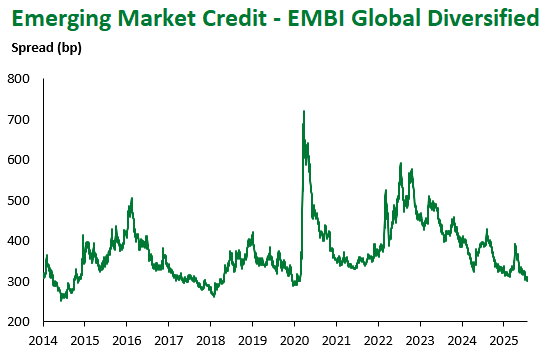
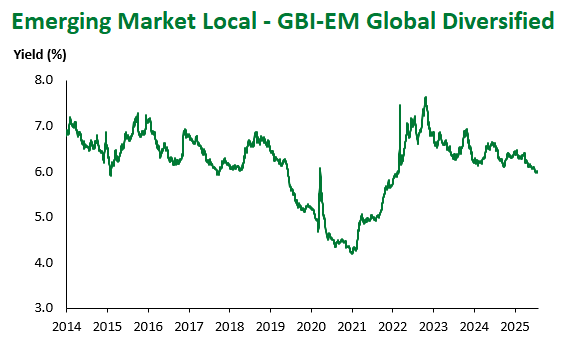

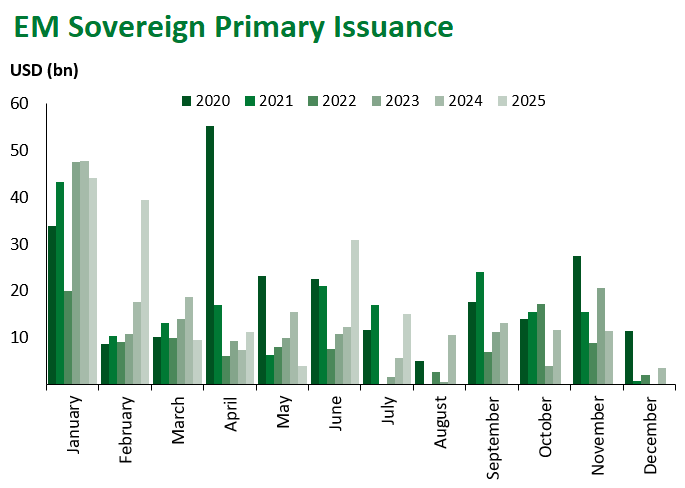
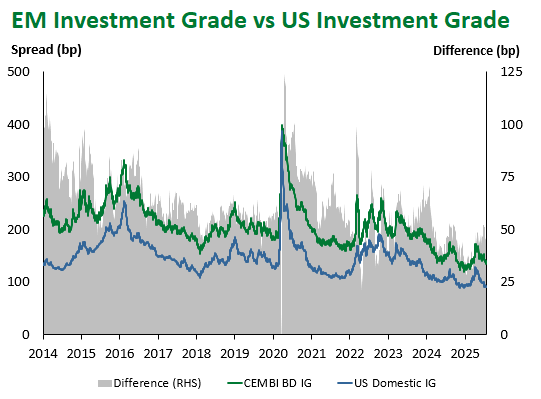
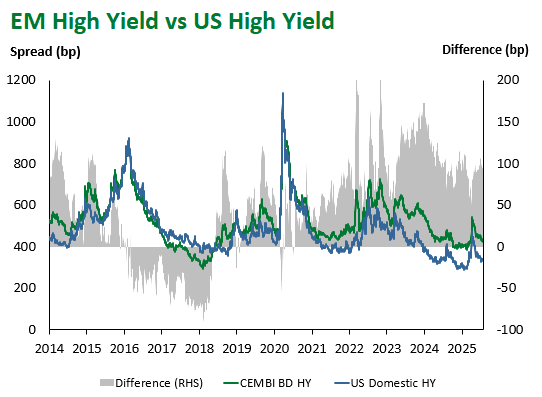
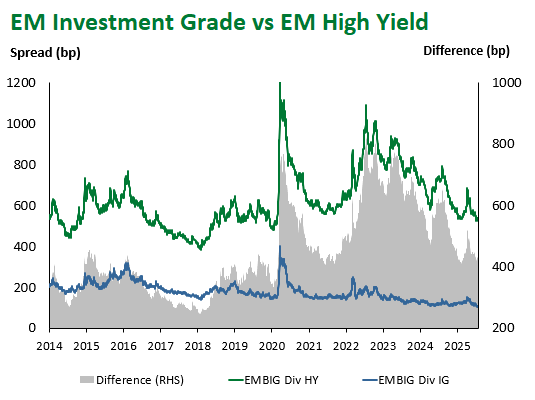
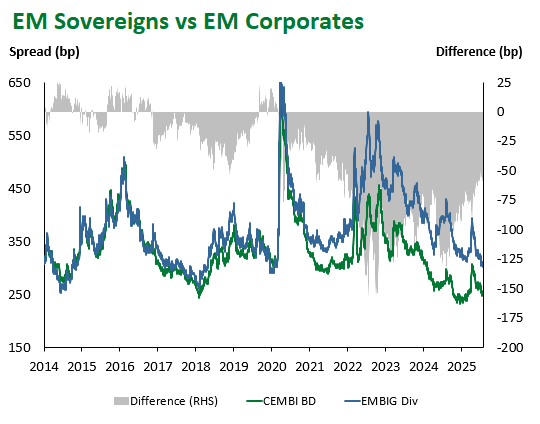
Emerging Markets Flows
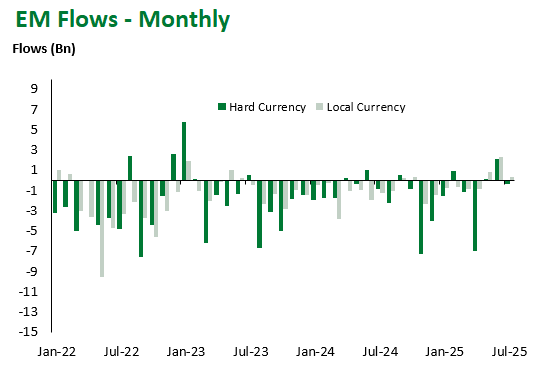

Source for graphs: Bloomberg, JPMorgan, Gramercy. As of July 25, 2025.
For questions, please contact:
Kathryn Exum, CFA ESG, Director, Co-Head of Sovereign Research, [email protected]
Petar Atanasov, Director, Co-Head of Sovereign Research, [email protected]
This document is for informational purposes only. The information presented is not intended to be relied upon as a forecast, research or investment advice, and is not a recommendation, offer or solicitation to buy or sell any securities or to adopt any investment strategy. Gramercy may have current investment positions in the securities or sovereigns mentioned above. The information and opinions contained in this paper are as of the date of initial publication, derived from proprietary and nonproprietary sources deemed by Gramercy to be reliable, are not necessarily all-inclusive and are not guaranteed as to accuracy. This paper may contain “forward-looking” information that is not purely historical in nature. Such information may include, among other things, projections and forecasts. There is no guarantee that any forecasts made will come to pass. Reliance upon information in this paper is at the sole discretion of the reader. You should not rely on this presentation as the basis upon which to make an investment decision. Investment involves risk. There can be no assurance that investment objectives will be achieved. Investors must be prepared to bear the risk of a total loss of their investment. These risks are often heightened for investments in emerging/developing markets or smaller capital markets. International investing involves risks, including risks related to foreign currency, limited liquidity, less government regulation, and the possibility of substantial volatility due to adverse political, economic or other developments. References to any indices are for informational and general comparative purposes only. The performance data of various indices mentioned in this update are updated and released on a periodic basis before finalization. The performance data of various indices presented herein was current as of the date of the presentation. Please refer to data returns of the separate indices if you desire additional or updated information. Indices are unmanaged, and their performance results do not reflect the impact of fees, expenses, or taxes that may be incurred through an investment with Gramercy. Returns for indices assume dividend reinvestment. An investment cannot be made directly in an index. Accordingly, comparing results shown to those of such indices may be of limited use. The information provided herein is neither tax nor legal advice. Investors should speak to their tax professional for specific information regarding their tax situation.
